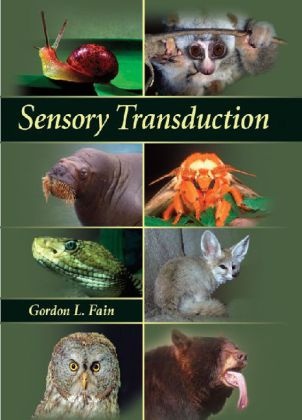Read more
Zusatztext An excellent course resource for sensory neuroscience or as a companion work in general neuroscience courses! and a good general resource for anyone seriously interested in neural cell biology and biochemistry! or neural mechanisms of behavior. Informationen zum Autor Gordon L. Fain Klappentext How are sights! sounds and smells converted into electrical signals in a form that can be interpreted by the nervous system? This process called sensory transduction began to be understood only recently as a result of the development of the techniques of patch-clamp recording and gene cloning.Beginning with fundamental properties of ion channels and G-protein coupled signal cascades! Sensory Transduction provides a comprehensive survey of this new knowledge that! taken as a whole! represents one of the greatest achievements of modern biology and neuroscience: the unravelling of the mechanism of sensation. Zusammenfassung Published by Sinauer Associates! an imprint of Oxford University Press. Since the time of the ancient Greeks! we have wondered how our sense organs tell us about the world around us. During the nineteenth and twentieth centuries! the anatomy of sensory tissues was described in considerable detail! and important discoveries were made about the proteins and electrical responses of sensory receptors. The most interesting question! however! continued to elude us: how are sights and sounds and smells converted into electrical signals in a form that can be interpreted bythe nervous system?This process! called sensory transduction! began to be understood only recently! as a result of the development of the techniques of patch-clamp recording and gene cloning. So much progress has now been made that it is possible to say at least in outline (but in most cases in remarkable detail) how transduction occurs for all of the major sense organs of the body. In nearly every case! the external stimulus is caught by a protein embedded in the lipid membrane of the sensory receptor.This protein then changes conformation! either directly producing an electrical signal (as for touch receptors in the skin or for hair cells in the ear and vestibular system) or triggering an enzymatic cascade and a change in the concentration of an intracellular second messenger that generates the electricalresponse (as in the eye and nose).Beginning with fundamental properties of ion channels and G-protein coupled signal cascades! Sensory Transduction provides a comprehensive survey of this new knowledge that! taken as a whole! represents one of the greatest achievements of modern biology and neuroscience: the unraveling of the mechanism of sensation. Inhaltsverzeichnis The Senses.- Mechanisms of Sensation.- Channels and Electrical Signals.- Metabotropic Signal Transduction.- Mechanoreceptors and Touch.- Hair Cells and the Detection of Movement and Sound.- Chemoreception and the Sense of Smell.- Taste.- Photoreception.- Extra Sensory Receptors. ...
List of contents
The Senses.- Mechanisms of Sensation.- Channels and Electrical Signals.- Metabotropic Signal Transduction.- Mechanoreceptors and Touch.- Hair Cells and the Detection of Movement and Sound.- Chemoreception and the Sense of Smell.- Taste.- Photoreception.- Extra Sensory Receptors.

